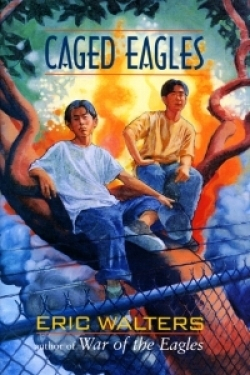
Caged Eagles
The much-awaited sequel to Walters’ award-winning War of the Eagles (1998), this story continues the tale of what happens to fourteen-year-old Tadashi Fukushima and his family after the Canadian government has ordered all Japanese-Canadians to pack up belongings shortly after Japan enters WWII. Surviving the rough trip along the coast of British Columbia in their cramped fishing boat, Tadashi and his family find themselves placed in an internment camp in the center of Vancouver. Here they are assigned separate living quarters; each family’s women and young children assigned to live in an old cattle stall in an overcrowded, large barn and the adult men assigned to a large dormitory.
It is here that Tadashi cannot understand why the men and women have been separated or why they must live in such cramped conditions, nor why the Canadian government sees fit to set up a school for the younger children if, as he believes, they will not be staying long. He finds some clarity in talking with a friend he meets named Sam, who explains much of what has happened to the Japanese-Canadians and introduces Tadashi to the daily routine of the camp—along with Sam’s own personal, not-permitted-by-the-rules way of coping with being trapped inside a perimeter fence. Still, Tadashi cannot fathom the injustice of the racism he and others in the camp are experiencing and he is especially angered and embittered by his grandmother’s words of acquiescence to the whole situation: “shikata-ga-nai” (it can’t be helped). When others risk their lives to help him when he breaks the rules and goes outside of the fence, Tadashi begins to realize what is at stake for his people. Only later, when his grandmother dies and the camp breaks the rules to give her a proper funeral pyre, does Tadashi fully understand his grandmother’s words and learn to cope with what he himself cannot control.
Though this book is listed for ages twelve to sixteen, many adults will find the story entertaining as well. Compelling and interesting, it is not just a fictional story, but educates readers about an era—of both Canadian and American History—which has been embarrassingly difficult to write or talk about because of the actions both governments took toward their own citizens during a time of war.
Reviewed by
Nelly Heitman
Disclosure: This article is not an endorsement, but a review. The publisher of this book provided free copies of the book to have their book reviewed by a professional reviewer. No fee was paid by the publisher for this review. Foreword Reviews only recommends books that we love. Foreword Magazine, Inc. is disclosing this in accordance with the Federal Trade Commission’s 16 CFR, Part 255.
